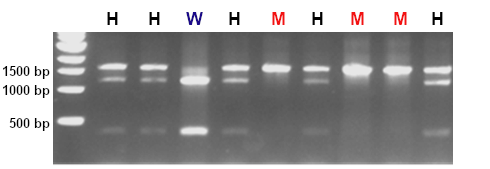Contributed by Wenjun Zhang and Jorge Dubcovsky
Financial support for marker and germplasm development: FFAR grant CA19-SS-0000000045
Starch is a major nutritional component of the wheat grain. One of the determinants of the nutritional value of starch is the relative proportion of amylose and amylopectin. Amylopectin is a highly branched glucose polymer that represents 70 to 80% of the starch dry weight and is readily digested by humans and other mammals, whereas amylose represents the other 20 to 30%, is less branched and forms complexes more resistant to digestion, mimicking dietary fibers.
Several enzymes are required for the synthesis of amylopectin, among them the starch branching enzyme II (SBEII), a transglycosylase, is a key enzyme for the addition of branching points during the synthesis of starch. In wheat, as in other cereals, there are two isoforms of SBEII: SBEIIa and SBEIIb. They are encoded by genes located on the long arm of chromosomes from homeologous group 2.
Regina et al. (1) and Sestili et. al (2) using RNA interference techniques in hexaploid and durum wheat, respectively, showed that the downregulation of SBEIIa induced increases in amylose content. Other evidence also suggested a role for SBEIIb in the absence of SBEIIa.
Hazard et al. (3) selected SBEII mutant lines from a ethyl methane sulfonate (EMS) mutant population derived from Desert durum variety "Kronos". They combined the linked SBEIIa and SBEIIb paralogs on chromosomes 2A (SBEIIa/b-A; PI 670159), 2B (SBEIIa/b-B; PI 670161), and on both chromosomes (SBEIIa/b-AB; PI 670160) of Kronos. These lines were developed through natural recombination and selection of recombinants with markers. Mutants for both paralogs on a single homoeolog showed nonsignificant increases in amylose and resistant starch content compared to the control. However, the quadruple mutant SBEIIa/b-AB showed large and significant increases in amylose (66%) and resistant starch (753%), but this line also had a 7% decrease in total starch and an 8% decrease in kernel weight. The authors made these lines available for further tests or breeding programs through the USDA-ARS National Center for Genetic Resources Preservation (4).
Markers for SBEIIa and SBEIIb
SBEIIa-A (dCAPS marker)
Primers:
F 5'- ACCCGCAGGTAAATTTAAAGCTTCAGT -3'
R 5'- TGCATCCTAAGTGGGAAACC -3'
PCR conditions: touch down 63-57ºC
Restriction enzyme: Mfe I
Expected products (bp):
wt: 1239, 398
mutant: 1637

SBEIIa-B (dCAPS marker)
Primers:
F 5'- CTAAGGATATTTTACATGCAACTGC -3'
R 5'- GAAATGCAATGGAAATCTTAGAG -3'
PCR conditions: annealing at 55ºC
Restriction enzyme: Pst I
Expected products (bp):
wt: 292, 24
mutant: 316

SBEIIb-A
Primers:
F 5'- TGCAATGTGAGCTACCGATAAG -3'
R 5'- ATGCTGTTCATCTGGGAAGTGC -3'
PCR conditions: annealing at 57ºC
Expected product: 552 bp. Both alleles amplify products of the same size. Use the forward primer for sequencing and determining the genotype.
SBEIIb-B
Primers:
F 5'- GAACATGTCTTGCATTACTCAG -3'
R 5'- GGTTGAGGATGCTTGAATACAT -3'
PCR conditions: annealing at 57ºC
Expected product: 372 bp. Both alleles amplify products of the same size. Use the reverse primer for sequencing and determining the genotype.
References
1. High-amylose wheat generated by RNA interference improves indices of large-bowel health in rats. Regina A, Bird A, Topping D, Bowden S, Freeman J, Barsby T, Kosar-Hashemi B, Li ZY, Rahman S, Morell M.
In: PNAS, 2006, 103:3546–3551. DOI:10.1073/pnas.0510737103.
2. Increasing the amylose content of durum wheat through silencing of the SBEIIa genes. Sestili F, Janni M, Doherty A, Botticella E, D’Ovidio R, Masci S, Jones HD, Lafiandra D. 2010. BMC Plant Biol. 10:144. DOI:10.1186/1471-2229-10-144.
3. Induced Mutations in the Starch Branching Enzyme II (SBEII) Genes Increase Amylose and Resistant Starch Content in Durum Wheat. Hazard B, Zhang X, Colasuonno P, Uauy C, Beckles DM, Dubcovsky J. In: Crop Science, 2012, 52: 1754-1766. DOI:10.2135/cropsci2012.02.0126.
4. Registration of Durum Wheat Germplasm Lines with Combined Mutations in SBEIIa and SBEIIb Genes Conferring Increased Amylose and Resistant Starch. Hazard B, Zhang X, Naemeh M, Dubcovsky J. In: Journal of Plant Registrations, 2014, 8: 334-338. DOI:10.3198/jpr2014.02.0007crg.
